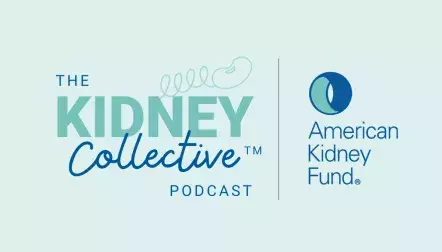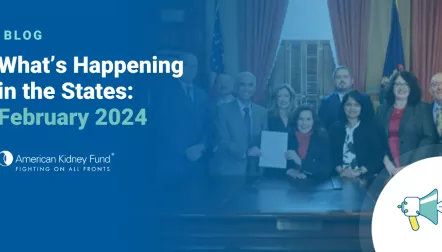
Blog post
Provisions in the Inflation Reduction Act that could help people with and at risk for kidney disease
Editor's note: This blog post contains a number of insurance-related terms that may not be familiar to everyone. To help you understand the protections this new bill provides, we have included a glossary to explain those terms.

On Aug. 16, President Biden signed into law the Inflation Reduction Act (IRA), sweeping legislation that addresses climate change, federal taxes and health care. Given the wide-ranging nature of the bill, we wanted to highlight some of its key health care provisions that could help people at risk for kidney disease and people with kidney disease or other chronic conditions.
Out-of-pocket spending cap for Medicare Part D beneficiaries
The new law will cap annual out-of-pocket (OOP) spending on prescription drugs for Medicare Part D beneficiaries at $2,000 starting in 2025. The IRA will also allow beneficiaries to spread out their OOP costs over the course of the year, which will be helpful for individuals with high drug costs and who might reach the $2,000 OOP cap early in the year. Additionally, the new law limits how much the annual Part D premium can grow between 2024 to 2030.
Under current law there is no annual OOP cap for Part D beneficiaries. Individuals who do not qualify for Part D low-income subsidies and who spend about $3,000 OOP on brand name drugs in 2022 will reach the "catastrophic phase" of their Part D benefit. When you reach this phase, you must pay 5% coinsurance on their prescription drugs for the rest of the year.
The new $2,000 yearly cap on OOP costs will be helpful for Part D beneficiaries with high drug costs and who do not qualify for low-income subsidies. This includes people with kidney disease who may also have other chronic conditions that require costly medications to manage their health.
Expansion of eligibility for full Medicare Part D low-income subsidies
The IRA expands eligibility for full Medicare Part D low-income subsidies (LIS) to individuals with incomes up to 150% of the federal poverty level (FPL) and modest assets, starting in 2024. Part D LIS benefits help low-income beneficiaries cover the cost of their Part D premium, deductible and cost sharing. This expansion changes the eligibility for LIS from 135% to 150% of FPL.
Under current law, beneficiaries with incomes up to 135% of FPL are eligible for full Part D LIS benefits, which cover the full cost of the Part D premium and deductible and a portion of cost sharing. For beneficiaries with incomes between 135% and 150% of FPL, they are eligible for partial Part D LIS, which covers a portion of the Part D premium and deductible and a smaller portion of cost sharing. The new law will eliminate the partial LIS benefit and make those individuals eligible for the full LIS benefit. Expanding access to full Part D LIS will be beneficial for Medicare beneficiaries with end-stage renal disease (ESRD), many of whom have lower incomes. In 2019, nearly 60% of Medicare beneficiaries with ESRD qualified for LIS (full and partial), compared to 30% of Medicare beneficiaries without ESRD.
Limiting monthly copayments for insulin in Medicare
Starting in 2023, Medicare beneficiaries will pay no more than $35 per month for covered insulin products in Medicare Part D and for insulin furnished through durable medical equipment under Medicare Part B.
Diabetes is a leading cause of kidney disease, and making insulin more affordable for Medicare beneficiaries is critical to ensuring people can access necessary insulin products to manage their blood sugar levels. Additionally, making insulin more affordable is important for people with ESRD. In 2019, insulin accounted for the largest percentage of Part D spending for people with a kidney transplant and the second largest percentage of Part D spending for people receiving dialysis treatments.
Improving access to recommended vaccines for adults in Medicare and Medicaid
Starting in 2023, there will be no cost sharing for adult vaccines covered in Medicare Part D that are recommended by the Advisory Committee on Immunization Practices (ACIP). Adults enrolled in Medicaid will also have access to no cost sharing vaccines recommended by ACIP. Improved access to recommended vaccines is important for all individuals, but particularly for people living with or at risk for kidney disease.
Extending enhanced subsidies for ACA Marketplace plans
The IRA extends the enhanced premium tax credits (subsidies) for people buying health coverage through the Affordable Care Act (ACA) Marketplaces through 2025. The temporary enhanced subsidies were first made available in 2021 and were set to expire at the end of 2022. The enhanced subsidies have made health insurance more affordable for millions of Americans who purchase an ACA Marketplace plan, and the extension helps ensure they will not see a steep increase in their Marketplace premium payments for the upcoming year.
Having access to affordable and comprehensive health coverage is vital for all people, especially people who are at risk for kidney disease or who may have early stage chronic kidney disease and need access to providers that can help them manage their condition.
With these provisions, we are hopeful that the IRA will help improve the lives of the 37 million Americans currently living with kidney disease.
Glossary
Annual out-of-pocket maximum: The total amount of money that you must pay for health care services before insurance will provide full coverage. This does not include your premium (see below). Once you hit your annual out-of-pocket maximum, all services should be provided without any cost-sharing.
Coinsurance: The amount that you pay when you have a health care service provided. The amount is based on a percentage of the cost, and the percentage is outlined in your health insurance policy.
Copay: A predetermined amount that you pay when you have a health care service provided. It is a flat rate (not a percentage), and the amount is outlined in your health insurance policy.
Cost-sharing: The amount you are responsible to pay in addition to your premium. Cost-sharing can be coinsurance or copays. It can also include your deductible and costs that lead to your out-of-pocket maximum.
Deductible: The amount you must pay in addition to your premium before insurance coverage or different coinsurance or copays start. Please be aware that because of the Affordable Care Act, most preventative services, such as your yearly wellness physical, well woman examinations, mammograms or cancer screenings, must be provided for free.
Premium: The amount you pay usually monthly or quarterly for your health insurance plan.





